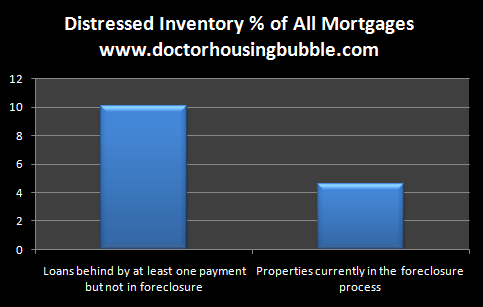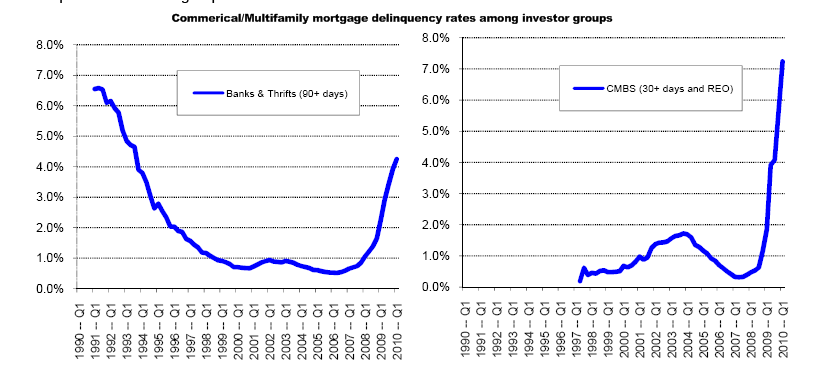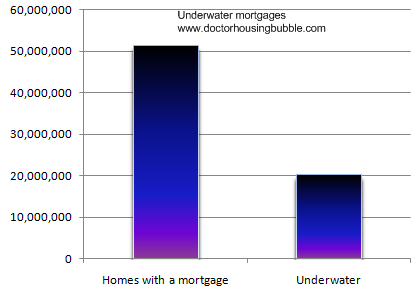By Lorraine Woellert and John Gittelsohn
June 14 (Bloomberg) — The cost of fixing Fannie Mae and Freddie Mac, the mortgage companies that last year bought or guaranteed three-quarters of all U.S. home loans, will be at least $160 billion and could grow to as much as $1 trillion after the biggest bailout in American history.
Fannie and Freddie, now 80 percent owned by U.S. taxpayers, already have drawn $145 billion from an unlimited line of government credit granted to ensure that home buyers can get loans while the private housing-finance industry is moribund. That surpasses the amount spent on rescues of American International Group Inc., General Motors Co. or Citigroup Inc., which have begun repaying their debts.
“It is the mother of all bailouts,” said Edward Pinto, a former chief credit officer at Fannie Mae, who is now a consultant to the mortgage-finance industry.
Fannie, based in Washington, and Freddie in McLean, Virginia, own or guarantee 53 percent of the nation’s $10.7 trillion in residential mortgages, according to a June 10 Federal Reserve report. Millions of bad loans issued during the housing bubble remain on their books, and delinquencies continue to rise. How deep in the hole Fannie and Freddie go depends on unemployment, interest rates and other drivers of home prices, according to the companies and economists who study them.
‘Worst-Case Scenario’
The Congressional Budget Office calculated in August 2009 that the companies would need $389 billion in federal subsidies through 2019, based on assumptions about delinquency rates of loans in their securities pools. The White House’s Office of Management and Budget estimated in February that aid could total as little as $160 billion if the economy strengthens.
If housing prices drop further, the companies may need more. Barclays Capital Inc. analysts put the price tag as high as $500 billion in a December report on mortgage-backed securities, assuming home prices decline another 20 percent and default rates triple.
Sean Egan, president of Egan-Jones Ratings Co. in Haverford, Pennsylvania, said that a 20 percent loss on the companies’ loans and guarantees, along the lines of other large market players such as Countrywide Financial Corp., now owned by Bank of America Corp., could cause even more damage.
“One trillion dollars is a reasonable worst-case scenario for the companies,” said Egan, whose firm warned customers away from municipal bond insurers in 2002 and downgraded Enron Corp. a month before its 2001 collapse.
Unfinished Business
A 20 percent decline in housing prices is possible, said David Rosenberg, chief economist for Gluskin Sheff & Associates Inc. in Toronto. Rosenberg, whose forecasts are more pessimistic than those of other economists, predicts a 15 percent drop.
“Worst case is probably 25 percent,” he said.
The median price of a home in the U.S. was $173,100 in April, down 25 percent from the July 2006 peak, according to the National Association of Realtors.
Fannie and Freddie are deeply wired into the U.S. and global financial systems. Figuring out how to stanch the losses and turn them into sustainable businesses is the biggest piece of unfinished business as Congress negotiates a Wall Street overhaul that could reach President Barack Obama’s desk by July.
Neither political party wants to risk damaging the mortgage market, said Douglas Holtz-Eakin, a former director of the Congressional Budget Office and White House economic adviser under President George W. Bush.
“Republicans and Democrats love putting Americans in houses, and there’s no getting around that,” Holtz-Eakin said.
‘Safest Place’
With no solution in sight, the companies may need billions of dollars from the Treasury Department each quarter. The alternative — cutting the federal lifeline and letting the companies default on their debts — would produce global economic tremors akin to the U.S. decision to go off the gold standard in the 1930s, said Robert J. Shiller, a professor of economics at Yale University in New Haven, Connecticut, who helped create the S&P/Case-Shiller indexes of property values.
“People all over the world think, ‘Where is the safest place I could possibly put my money?’ and that’s the U.S.,” Shiller said in an interview. “We can’t let Fannie and Freddie go. We have to stand up for them.”
Congress created the Federal National Mortgage Association, known as Fannie Mae, in 1938 to expand home ownership by buying mortgages from banks and other lenders and bundling them into bonds for investors. It set up the Federal Home Loan Mortgage Corp., Freddie Mac, in 1970 to compete with Fannie.
Lower Standards
The companies’ liabilities stem in large part from loans and mortgage-backed securities issued between 2005 and 2007. Directed by Congress to encourage lending to minorities and low- income borrowers at the same time private companies were gaining market share by pushing into subprime loans, Fannie and Freddie lowered their standards to take on high-risk mortgages.
Many of those went to borrowers with poor credit or little equity in their homes, according to company filings. By early 2008, more than $500 billion of loans guaranteed or held by Fannie and Freddie, about 10 percent of the total, were in subprime mortgages, according to Fed reports.
Fannie and Freddie also raised billions of dollars by selling their own corporate debt to investors around the world. The bonds are seen as safe because of an implicit government guarantee against default. Foreign governments, including China’s and Japan’s, hold $908 billion of such bonds, according to Fed data.
‘Debt Trap’
“Do we really want to go to the central bank of China and say, ‘Tough luck, boys’? That’s part of the problem,” said Karen Petrou, managing partner of Federal Financial Analytics Inc., a Washington-based research firm.
The terms of the 2008 Treasury bailout create further complications. Fannie and Freddie are required to pay a 10 percent annual dividend on the shares owned by taxpayers. So far, they owe $14.5 billion, more than the companies reported in income in their most profitable years.
“It’s like a debt trap,” said Qumber Hassan, a mortgage strategist at Credit Suisse Group AG in New York. “The more they draw, the more they have to pay.”
Fannie and Freddie also benefited by selling $1.4 trillion in mortgage-backed securities to the Fed and the Treasury since September 2008, bonds that otherwise would have weighed on their balance sheets. While the government bought only the lowest-risk securities, it could incur additional losses.
‘Hard to Judge’
Treasury Secretary Timothy F. Geithner has vowed to keep Fannie and Freddie operating.
“It’s very hard to judge what the scale of losses is,” Geithner told Congress in March.
One idea being weighed by the Obama administration involves reconstituting Fannie and Freddie into a “good bank” with performing loans and a “bad bank” to absorb the rest. That could cost taxpayers as much as $290 billion because of all the bad loans, according to a May estimate by Credit Suisse analysts.
At the end of March, borrowers were late making payments on $338.4 billion worth of Fannie and Freddie loans, up from $206.1 billion a year earlier, according to the companies’ first- quarter filings at the Securities and Exchange Commission.
The number of loans more than three months past due has risen every quarter for more than a year, hitting 5.5 percent at Fannie as of the end of March and 4.1 percent at Freddie, according to the filings.
Surge in Delinquencies
The composition of the $5.5 trillion of loans guaranteed by Fannie and Freddie suggests that the surge in delinquencies may continue. About $1.98 trillion of the loans were made in states with the nation’s highest foreclosure rates — California, Florida, Nevada and Arizona — and $1.13 trillion were issued in 2006 and 2007, when real estate values peaked. Mortgages on which borrowers owe more than 90 percent of a property’s value total $402 billion.
Fannie and Freddie may suffer additional losses as a result of the Treasury’s effort to prevent foreclosures. Under the program, banks with mortgages owned or guaranteed by the companies must rewrite loan terms to make them easier for borrowers to pay.
The Treasury program is budgeted to cost Fannie and Freddie $20 billion. The companies have already modified about 600,000 delinquent loans and refinanced almost 300,000 more, in some cases for an amount greater than the houses are worth.
The government is using Fannie and Freddie “for a public- policy purpose that may well increase the ultimate cost of the taxpayer rescue,” said Petrou of Federal Financial Analytics. “Treasury is rolling the dice.”
Republican Phase-Out
If the plan works and foreclosures fall, that could help stabilize Fannie’s and Freddie’s balance sheets and ultimately protect taxpayers.
“Avoiding foreclosures can be a route to reducing loss severity,” said Sarah Rosen Wartell, executive vice president of the Center for American Progress, a Washington research group with ties to the Obama administration.
Loans issued since 2008, when the companies raised standards for borrowers, should be profitable and help offset prior losses, Wartell said.
Republicans attempted to include a phase-out of the mortgage companies in the financial reform bill. Democratic lawmakers and the Obama administration opted for further study, and the Treasury began soliciting ideas in April.
Representative Scott Garrett, a New Jersey Republican and co-sponsor of the phase-out amendment, said eliminating Fannie and Freddie would force the government and the housing market to confront the issue.
“It’s somewhat impossible to predict the magnitude of their impact if they continue to be the primary source of lending,” Garrett said in an interview.
Caught in ‘Quandary’
Democrats dismissed the phase-out idea as simplistic.
“We need to have a housing-financing system in place,” Senate Banking Committee Chairman Christopher Dodd said last month. “If you pull that rug out at this particular juncture, I don’t know what the particular result would be. We’re caught in this quandary.”
By delaying action, the Obama administration keeps losses off the government’s books while building a floor under housing prices during a congressional election year.
Keeping Fannie and Freddie functioning could also support an overall economic recovery. Residential real estate — the money spent on rent, mortgage payments, construction, remodeling, utilities and brokers’ fees — accounted for about 17 percent of gross domestic product in 2009, according to the National Association of Home Builders.
‘Already Lost’
Allowing the companies to go under and hoping that private financing will fill the gap isn’t realistic, analysts say. It would require at least two years of rising property values for private companies to return to the mortgage-securitization market, said Robert Van Order, Freddie’s former chief international economist and a professor of finance at George Washington University in Washington.
The price tag of supporting Fannie and Freddie “needs to be evaluated against the cost of not having a mortgage market,” said Phyllis Caldwell, chief of the Treasury’s Homeownership Preservation Office.
Whatever the fix, the money spent will not be recovered, said Alex Pollock, a former president of the Federal Home Loan Bank of Chicago who is now a fellow at the Washington-based American Enterprise Institute.
“It doesn’t matter what you do or don’t do, Fannie and Freddie will cost a lot of money,” Pollock said. “The money is already lost. There’s an attempt to try to avert your eyes.”
To contact the reporter on this story: Lorraine Woellert in Washington at lwoellert@bloomberg.net; John Gittelsohn in New York at johngitt@bloomberg.net.
Last Updated: June 13, 2010 19:00 EDT
© 2010-19 FORECLOSURE FRAUD | by DinSFLA. All rights reserved.













 the latest evidence of the government’s false sense of security during the go-go days of the financial boom. Just as bank executives got bonuses despite taking on dangerous amounts of risk, regulators got taxpayer-funded bonuses despite missing or ignoring signs that the system was on the verge of a meltdown.
the latest evidence of the government’s false sense of security during the go-go days of the financial boom. Just as bank executives got bonuses despite taking on dangerous amounts of risk, regulators got taxpayer-funded bonuses despite missing or ignoring signs that the system was on the verge of a meltdown.


Recent Comments